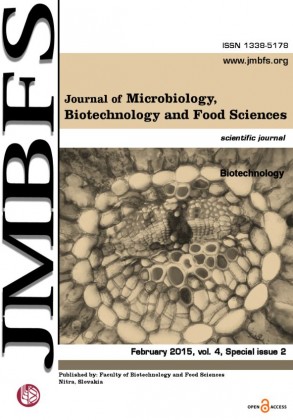ANALYSIS OF STABILITY OF TRINUCLEOTIDE TTC MOTIFS IN COMMON FLAX PLANTED IN THE CHERNOBYL AREA
DOI:
https://doi.org/10.15414/jmbfs.2015.4.special2.70-72Keywords:
Flax, Linum usitatissimum L., microsatellites, PCRAbstract
Flax (Linum usitatissimum L.) is one of the oldest domesticated plants — it was cultivated as early as in ancient Egypt and Samaria 10,000 years ago to serve as a source of fiber and oil, whence it later spread around the world. Compared with other plants, the flax genome consists of a high number of repetitive sequences, middle repetitive sequences and small repetitive sequences of nucleotides. The aim of the study was to analyze the stability of the existing trinucleotides motifs of microsatellite DNA of the flax genome (genotype Kyivskyi), growing in the Chernobyl conditions. The Chernobyl area is the most extensive “natural†laboratory suitable for the study of radiation effects. Over the last 20 years, the researches collected important knowledge about the effects of low and high radiation doses on the DNA isolated from the plant material growing on the remediated fields near Chernobyl and the plant material from fields contaminated by radioactive cesium 137Cs and strontium 90Sr. Using eight pairs of microsatellite primers, we successfully amplified the samples from the remediated fields. For each primer in the control samples and remediated samples, we detected 1 to 3 fragments per locus, each in size up to 120 to 250 base pairs. The applied microsatellite primers confirmed the monomorphic condition of microsatellite loci.Downloads
Download data is not yet available.
Downloads
Published
2015-02-02
How to Cite
Lancíková, V., Hlavačková, L., Žiarovská, J., Kubíková, H., Bežo, M., Ražná, K., Danchenko, M., Rashydov, N., & Hajduch, M. (2015). ANALYSIS OF STABILITY OF TRINUCLEOTIDE TTC MOTIFS IN COMMON FLAX PLANTED IN THE CHERNOBYL AREA. Journal of Microbiology, Biotechnology and Food Sciences, 4(special issue 2 (Biotechnology), 70–72. https://doi.org/10.15414/jmbfs.2015.4.special2.70-72
Issue
Section
Biotechnology
License
Copyright (c) 2015 Veronika LancÃková, Lucia HlavaÄková, Jana Žiarovská, Hana KubÃková, Milan Bežo, KatarÃÂna Ražná, Maksym Danchenko, Namik Rashydov, Martin Hajduch

This work is licensed under a Creative Commons Attribution 4.0 International License.
All papers published in the Journal of Microbiology, Biotechnology and Food Sciences are published under a CC-BY licence (CC-BY 4.0). Published materials can be shared (copy and redistribute the material in any medium or format) and adapted (remix, transform, and build upon the material for any purpose, even commercially) with specifying the author(s).





